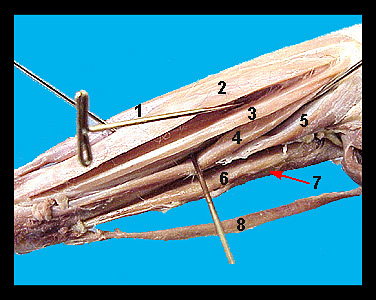|
|
|
|
||||||||||||||||||||||||||||||||||||||||||||||||||||||||||||||||||||
|
This image shows some of the superficial muscles on the ventral aspect of the forearm. This group of muscles functions in flexion of the wrist (paw) and digits and most are named accordingly. Just medial to the exposed ulna is the flexor carpi ulnaris. This muscle can cause confusion because it has two heads, an ulnar head (small) and a humeral head (larger). The tendons of the two heads converge to form a common tendon that inserts on the carpals. This muscle is a wrist flexor. Adjacent to the flexor carpi ulnaris, moving medially, is the wide, flat palmaris longus. This muscle originates on the medial epicondyle of the humerus and inserts on the middle phalanx of digits two through five. Its action is flexion of the digits. Immediately medial to the palmaris longus is the humeral head of the flexor digitorum profundus. The five heads of this muscle have multiple origins that insert on the distal phalanx of digits one through five. Its action is to flex all digits. The next tendon encountered is that of the flexor carpi radialis. This muscle originates on the medial epicondyle of the humerus and inserts on the metacarpals. Its action is to flex the wrist. Lastly, there is an obliquely oriented muscle in the upper ventral surface of the forearm. This is the pronator teres. Its origin is the medial epicondyle of the humerus and its insertion is the radius. It produces pronation of the paw by rotating the radius. |
|
